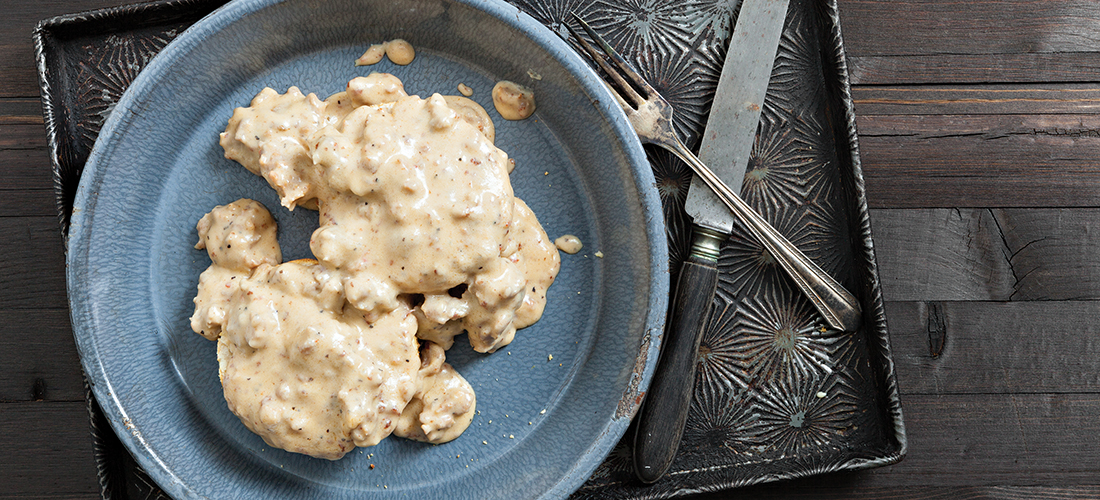
Good Gravy
The hot and heavy love affair that keeps me coming back for more
By David Claude Bailey
My father said he couldn’t wait to go to heaven. He’d heard that everything there came with gravy on top of it.
I’m my father’s son, and please consider this a Valentine to the elixir of life, to mother’s milk (with a little pan juices, flour and fat thrown in), to no less than my favorite food group — gravy.
Oh good gravy, how I love thee. And I’m not alone. My idol, Dolly Parton, once admitted, “Every time I fell off a diet was because of potatoes and gravy of some sort.” And the late American humorist Erma Bombeck once quipped, “I come from a family where gravy is considered a beverage.”
(By the way, Dad, how’s chocolate ice cream topped with sawmill gravy?)
Speaking of sawmill gravy, it was my father’s favorite — and mine too, though red-eye gravy and chicken-fried milk gravy are close contenders. At any rate, on the rare occasion Dad couldn’t jet home from work for a half-hour lunch because he was covering for another employee (which he inevitably did as manager of the Belk store in Reidsville), he’d go to Miller’s Cafe, put a napkin in his lap and, presto, a plate of biscuits, carpeted with sawmill gravy would appear, along with a cup of black coffee and a bottle of Texas Pete. Maybe you think sawmill gravy with biscuits isn’t exactly a well-balanced meal, but consider this: at the base of this Southern food pyramid are the biscuits, made from wholesome Midwestern-raised grain, bleached to perfection. Your dairy requirement? Isn’t gravy loaded with milk? Protein? The sausage bits swimming around the plate. And vegetables? Isn’t that why they put sage in Southern sausage?
My wife, Anne, makes superb gravy when she will. (Why would anyone leave a frying pan on the stove in which meat has been cooked without making gravy?) Anne’s finest is the milk gravy she makes after frying venison cutlets in bacon fat. Serve it on rice and you have to be careful not to swallow your tongue. When she heard I was writing about gravy, she wrinkled her nose the way she does and said, “OK, Mr. Smarty Chef Pants, what is gravy? And what’s the difference between a gravy and a sauce?”
“Good question,” I answered, which is what people on NPR say when they’re put on the spot. I spent several months as a backline chef in a French restaurant, so I know what gravy is. Besides, I grew up eating gallons of it, made by the finest Pennsylvania-Dutch cook in the South, my mother. Her hallowed gravy boat buoyed mahogany pot-roast gravy, silky gravy made from roast chicken, potent and peppery au jus from roast beef and the milk gravy I learned how to make from watching her. She’d sprinkle a heaping tablespoon of flour and lots of pepper into her midnight-black, cast-iron skillet that was still sizzling with fat and pan drippings from frying fatback. She’d scrape up any crunchies sticking to the pan as the flour browned, then add milk slowly as she whisked the flour in and let it thicken. What could be simpler? But when does a gravy become a sauce and vice versa?
I decided to consult Monsieur Larousse, as in Larousse Gastronomique. “You must understand, my American friend, we cook sauces, not gravy.” That’s what was channeled into my mind’s ear as I read the 15 pages devoted solely to sauces in Larousse. The closest thing to gravy, my Gastronomical friend said, is a demi-glaze, aka brown sauce, which has as its base dark and classic Espagnole sauce.
“This has nothing to do with Spain,” Monsieur Larousse interjected from his massive tome. “We call it Espagnole sauce because Spaniards are dark. And because Germans are blonde, we refer to the much lighter sauce made from veal or poultry as sauce Allemande.” To make Espagnole sauce, I learned from Larousse, be prepared to boil bones, meat, carrots, onion, thyme, bay leaf and bacon for hours, draining and straining and skimming and recooking it multiple times. I remember how at Print Works Bistro I’d be tasked with pouring off the broth that had been cooking for hours in a 20-gallon steam jacket. The result was wonderful. But not gravy.
Miss Fannie, as in Miss Fannie Farmer, calls pan drippings “the simplest, purest gravy imaginable.” Amen, sister. Keep it simple. Scrape the browned bits from the pan in which the meat has been cooked, she says, along with two tablespoons of fat. Add salt, pepper and a half cup of water or broth and stir. Want a thick gravy? Make a roux as my momma did with the pan fat or thicken the mixture with flour or corn starch stirred into cold water and then added to the pan. Easy, peasy, but stir, stir, stir to prevent lumping.
But what if a cook chooses to enhance a gravy with cream, eggs, wine or spices other than salt and pepper? Surely it then becomes a sauce. Both of my daughters say that their favorite gravy is their own dad’s proprietary red-eye gravy. I fry country ham only long enough to create something to scrape. Then I add enough coffee (espresso because that’s what I drink) to deglaze the pan. Lots of pepper, NOT salt, a dash of Worcestershire and Texas Pete, and, finally, I add, yes, Coca-Cola to sweeten it just a tad, not more than a tablespoon. Then, top it off with water until it’s the right strength. If you don’t put it on grits, you weren’t raised right.
The question is, with those fancy ingredients, is it a sauce or gravy? Miss Joy (as in Joy of Cooking), for instance, classifies “pan gravy” as just another sauce. As does the authoritative John Mariani. Gravy, he says, is “a sauce, usually flour-based, served with meat, poultry and other foods.” But I’m pretty sure that neither of them are from the South.
Confused, I finally decided to ask Noah Webster: “A sauce made from the thickened and seasoned juice of cooked meat.”
Why didn’t I look in the dictionary in the first place?
Now that you know all that, why don’t you get up early February 14, fry up some Neese’s Extra Sage Country Sausage, pop a can of refrigerator biscuits if you don’t enjoy making them from scratch, and see if your significant other doesn’t love you once, love you twice, love you better than gravy and rice. OH
As a dinner guest, O.Henry’s Contributing Editor David Claude Bailey has been known to jump up from the table after volunteering to make gravy. And he insists no one has ever been disappointed because he did.





